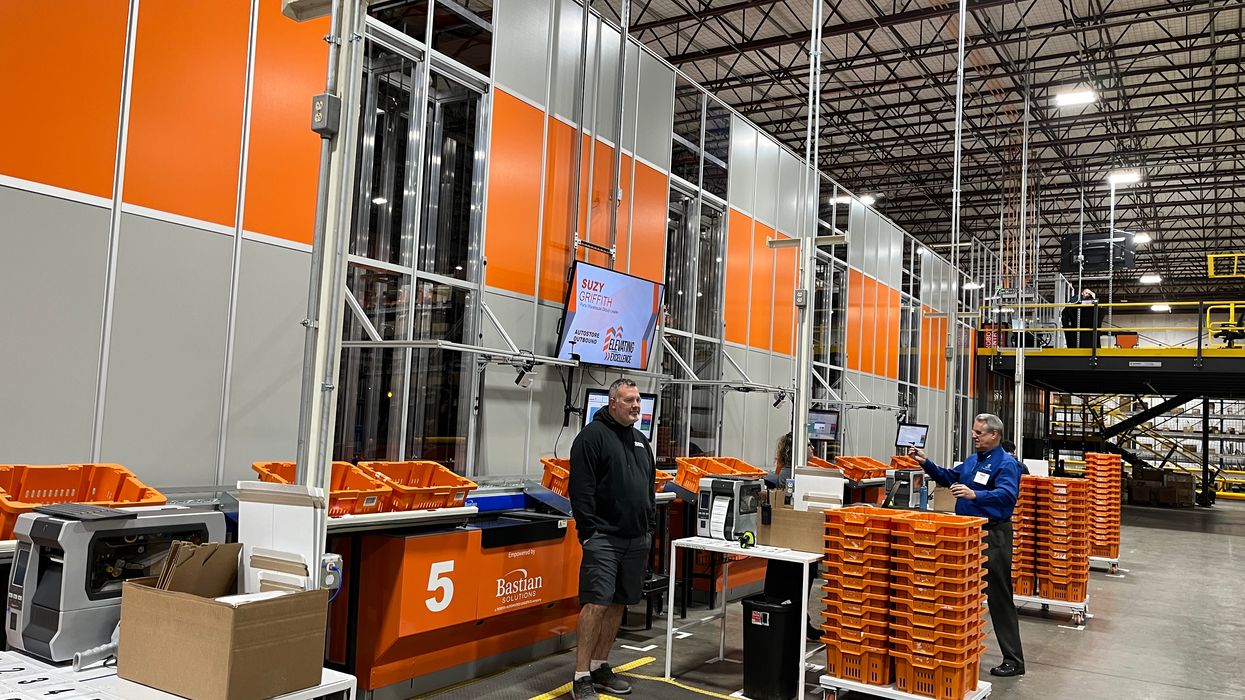With its new AutoStore automated storage and retrieval (AS/RS) system, Toyota Material Handling Inc.’s parts distribution center, located at its U.S. headquarters campus in Columbus, Indiana, will be able to store more forklift and other parts and move them more quickly. The new system represents a major step toward achieving TMH’s goal of next-day parts delivery to 98% of its customers in the U.S. and Canada by 2030, said TMH North America President and CEO Brett Wood at the launch event on October 28. The upgrade to the DC was designed, built, and installed through a close collaboration between TMH, AutoStore, and Bastian Solutions, the Toyota-owned material handling automation designer and systems integrator that is a cornerstone of the forklift maker’s Toyota Automated Logistics business unit. The AS/RS is Bastian’s 100th AutoStore installation in North America.
TMH’s AutoStore system deploys 28 energy-efficient robotic shuttles to retrieve and deliver totes from within a vertical storage grid. To expedite processing, artificial intelligence (AI)-enhanced software determines optimal storage locations based on whether parts are high- or low-demand items. The shuttles, each independently controlled and selected based on shortest distance to the stored tote, swiftly deliver the ordered parts to four picking ports. Each port can process up to 175 totes per hour; the company’s initial goal is 150 totes per hour, with room to grow. The AS/RS also eliminates the need for order pickers to walk up to 10 miles per day, saving time, boosting picking accuracy, and improving ergonomics for associates.
The upgrades, which also include a Kardex vertical lift module for parts that are too large for the AS/RS and a spiral conveyor, will more than triple storage capacity, from 40,000 to 128,000 storage positions, making it possible for TMH to increase its parts inventory. Currently the DC stores some 55,000 stock-keeping units (SKUs) and ships an average of $1 million worth of parts per day, reaching 80% of customers by two-day ground delivery. A Sparck Technologies CVP Impack fit-to-size packaging machine speeds packing and shipping and is expected to save up to 20% on the cost of packing materials.
Distribution, manufacturing expansion on the agenda
The Columbus parts DC currently serves all of the U.S. and Canada; inventory consists mostly of Toyota’s own parts as well as some parts for Bastian Solutions and forklift maker The Raymond Corp., which is part of TMH North America. To meet the company’s goal of next-day delivery to virtually all parts customers, TMH is exploring establishing up to five additional parts DCs. All will be TMH-designed, owned, and operated, with varying levels of automation to meet specific needs, said Bret Bruin, vice president, aftermarket sales and operations, in an interview.
Parts distribution is not the only area where TMH is investing in expanded capacity. With demand for electric forklifts continuing to rise, the company recently broke ground for a new factory on the expansive Columbus campus that will benefit both Toyota and Raymond. The two OEMs—which currently have only 5% overlap among their customers—already manufacture certain forklift models and parts for each other, said Wood in an interview. Slated to open in 2026, the $100 million, 295,000-square-foot factory will make electric-powered forklifts. The lineup will include stand-up rider trucks, currently manufactured for both brands by Raymond in Greene, New York. Moving production to Columbus, Wood said, will not only help both OEMs keep up with fast-growing demand for those models, but it will also free up space and personnel in Raymond’s factory to increase production of orderpickers and reach trucks, which it produces for both brands. “We want to build the right trucks in the right place,” Wood said.
Editor's note:This article was revised on November 4 to correct the types of equipment produced in Raymond's factory.















